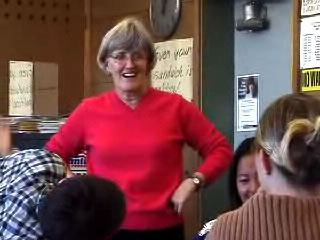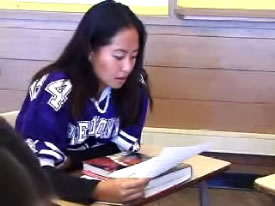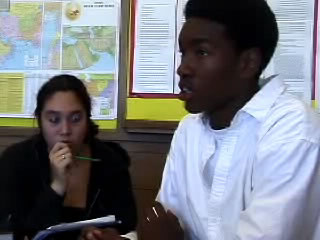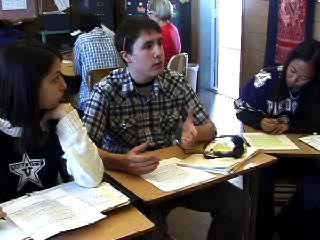JOAN
CONE •
EL CERRITO HIGH SCHOOL • El Cerrito, CA
with Desiree Pointer and the Knowledge
Media Lab of The Carnegie Foundation
Constructing Urban High School Students as Achievers




Print Other Work by Joan Cone:
Monograph:Co-constructing Low Achievement (pdf)
"The Gap is in Our Expectations," Newsday, 5/26/02 (pdf)
Poster: Co-constructing Low Achievement (JPG)
Reflective Video Analysis of Classroom Period
Download Joan Cone's Materials and Strategies
- SOAPS: strategies for analyzing text (pdf)
- English AP Prompt (JPG)
- Students' Prompts Marked with Text Analysis Notations
View Video:
Entire class session(streaming)
Reflective Video Analysis of Classroom Period
Link to Related Work:
Jeannie Oakes, "Detracking: The Social Construction of Ability, Cultural Politics, and Resistance to Reform"
Timothy Boerst, "Ownership of Learning"
Yvonne Divans Hutchinson, "A Friend of Their Minds"
Constructing
Urban High School Students as Achievers
Essential practices for constructing students as achievers in the
high school English class.
We as teachers have a pedagogical and moral obligation to interrupt the
process of co-construction of low achievement. It is my experience as
a detracking advocate that there are three essential practices that contribute
to the construction of students as achievers. 1) we need to create
a classroom environment in which students feel safe to participate
in the academic and social conversations of the class. 2) We need to address
issues of power in the classroom around reading and writing competencies.
And 3), we need to mix and remix students in groups
so that all students will see that they can learn with and from each other.
While these practices inform everything I do in my classroom, they are
not limited to the English classroom. All teachers need to look for ways
to employ these practices and thereby invite their students to construct
themselves as achievers.
(Note: This page will be linked to student work and instructional materials
in early September)
| Quicklinks |
- Create
a safe classroom environment for achievement
In the first days of my first untracked AP English class (“Untracking AP English: Creating Opportunity Is Not Enough,” Kappan, May, 1992), I learned the necessity of establishing a classroom environment in which students feel safe as learners. At the end of the first week of class, Paula told me she was transferring out of the class: “I can’t talk like these kids.” New to an honors level English class and intimidated by the articulateness of her peers and their ease (sometimes aggressiveness) in participating in discussions, Paula wanted out. Her words put me on notice: I had to find a way to create a classroom environment in which she and students like her felt safe asking questions, trying out interpretations, reading their work, making mistakes, learning with and from other students. Thus was born my practice of using models.
Now I regularly ask students to write and read personal pieces using models written by such writers as Toni Morrison and E. B. White. Every time I listen to what students choose to reveal in these pieces, I am amazed at the kind of openness the models invite and the personal details students share with their peers.
On the first day of school I hand out “I am Sarah”—a model patterned loosely on a piece written by a former student. The next day, we read our self-introductions from the author’s chair and then post them on the bulletin board with a recent photograph. Every several weeks, I hand out another model and ask students to write and read their work from the author’s chair—as a way to build cohesion in the class and to establish and reestablish each student’s place in the class. - I am Sarah model/ I am Sarah example-student / I am Sarah example- teacher
- Bull Durham credo model
- Jazz found poem model / Jazz found poem example
- Just Because model
- Address
issues of power in the classroom around reading and writing competencies.
In “the Silenced Dialogue” [1995], Lisa Delpit lists five aspects of power that play out in classrooms. Delpit’s fourth aspect—“If you are not already a participant in the culture of power, being told explicitly the rules of that culture makes acquiring power easier”—challenges me as a detracking advocate and English teacher. How do I explicitly teach the “rules” (conventions, strategies, habits) that will empower low-skilled students to succeed as readers and writers and at the same time meet the needs of high-skilled students? Rather than track students within my untracked class, I have devised various strategies that address diverse skill levels and build reading and writing competence.- Writing
Strategies:
- Dictation
and style sheets
To address issues of correctness (grammar, usage, mechanics), I use dictations and style sheets. Each time I grade a set of papers, I keep a running list of points I want to address for a whole-group lesson. I then devise either a dictation or a style sheet that includes the points I see as most necessary to address. In writing the dictations and style sheets, I choose points from papers of skilled as well as unskilled writers so that my lessons is directed at all levels. The day I return the set of papers, I give the dictation or hand out the style sheet and discuss the specific points that came up in the set of papers. I do not give tests on these points, but I do review the sheets regularly and ask students to use the sheets when they proofread their own papers and work in writing response groups. - Semi-colons,
colons and dashes
Early in the year, I teach students to use these three kinds of punctuation. It’s my experience that when students begin to incorporate these forms into their writing (especially semi-colons), their writing becomes more sophisticated and their thinking more complex.
- Dictation
and style sheets
- Reading
strategies:
Four basic beliefs inform my teaching of reading: 1) reading is a social, cultural, and linguistic act as well as a cognitive act; 2) reading is a process of meaning-making; 3) teachers need to present students with a wide range of texts by writers who reflect the racial and ethnic backgrounds of their students; 4) all high school students benefit from discipline-specific reading instruction. - Reading
nonfiction
I use the SOAPS strategy to teach students to read non-fiction pieces. To being with, I choose a relatively easy piece from a local editorial page. My students and I read the piece together and then I ask students to read it again silently and figure out the SOAPS. Then, moving through each letter—S, O, A, P, S—I call on students to read what they have written. My purpose in asking several students for each letter is to give students the idea that there is no one, specific “right” answer. The answers they give for the A[udience] and P[urpose] provide particularly rich teaching moments because students quickly learn that writers write for a variety of audiences and purposes.
Once students learn how to apply SOAPS to newspaper articles and op ed pieces, I bring in longer pieces: magazine articles, chapters from books (such as Fast Food Nation and King Leopold’s Ghost), and documentary films (such as The Thin Blue Line, Four Little Girls, I Am Not a Freak.) I make it a point to bring in pieces on science, popular culture, medicine, and national and global events to expose students to issues they might not read about on their own.
When students are comfortable using SOAPS to work through non-fiction pieces, I teach them how to write an argument-in-response-to-an-argument using a three-part essay model. To assist students with the first part of the essay, I give them lists of words to use in summarizing or in making claims about the ideas of the writer. I attend to the diverse writing skills in the class by encouraging the more proficient writers to write several paragraphs for the middle part—including various concession paragraphs as well as pro paragraphs (see Lucille Payne, 1983).
Once students understand the logic of the three-part argument-on-an-argument, I give them practice using it on various prompts used in the AP English Language and Composition exam (see http://apcentral.collegeboard.com/) and in the University of California College Writing Entrance exam. - Reading
fiction
I begin the school year with short engaging stories such as Tallent’s “No One’s a Mystery,” Bambara’s “The Lesson,” Heckor’s “The Birthday Party,” and Peck’s “I Go Along.” In leading discussions on these stories, I make clear that in our study of literature, I will never ask students to find the “right” answer in texts; I will ask them to work out their own interpretations of texts and to participate with their peers in public meaning making of those texts. I also make clear that I will never call on them to read unfamiliar texts aloud—if they want to read, they can volunteer.
In teaching students to read fiction, I use a mix of Louise Rosenblatt (1938) and Peter Rabinowitz (1987). I emphasize Rosenblatt in the beginning—especially her theory that reading is transacting with text and her ideas about reading from aesthetic and efferent stances. I use Rabinowitz to teach conventions used by fiction writers.
I spend a good deal of time getting students into texts. Sometimes I give them an excerpt from the book and have them read that as a way of getting familiar with important characters or with a writer’s style. Before beginning Toni Morrison’s Sula, for example, I hand out the excerpt where Nel and Sula meet the Irish boys (pages 52-55). We read the pages aloud and then I ask students to write about and then discuss what they know about Sula and Nel from the excerpt. That exercise introduces students to the dynamics of the girls’ relationship and a major theme in the book. Another example: in beginning Chang-Rae Lee’s Native Speaker, I ask students to read the first chapter silently and then make a list of everything they know about the main character and his wife. After they discuss their lists, we read the chapter aloud and add to the lists. I collect the lists and hand them back when we have finished the book—to demonstrate to students how masterfully good writers construct the first chapter of books. Asking students to write before beginning the discussions is important: it encourages them to develop personal interpretations and it provides shy students with a “script” for joining the class discussion. - Close
reading and stylistic analysis
Once students have had practice making meaning of a variety of texts, I teach them strategies for close reading and stylistic analysis. I begin with a short but provocative piece such as Robert Hayden’s poem, “The Whipping.” We read the piece three times (twice aloud, once silently) and then I ask students what is happening in the piece. Once we get that established, I ask students to read the poem again with a focus on the choices Hayden made in writing the poem. I have them circle or highlight words they see as particularly effective, words that Hayden chose specifically to use to make the piece work. Then I have them underline effective details he used and think about why he used them. Finally, I have them think about how Hayden organized the poem and how that organization served him.
After students have worked through various pieces focusing on such issues as diction, detail, syntax, organization, tone, and point of view, I have them work in small groups, using pieces from books we’ve read as a class, articles from newspapers and magazines, and prompts from past AP English Language examinations. In teaching students to do close reading, I play the role of a guide through the pieces, not an authority on them. I ask questions, push for deeper interpretations and extended commentaries, draw attention to various aspects of the text students miss. When students work in groups, they guide each other.
As students grow in their ability to do close reading, I introduce various literary terms—common ones for ninth graders (metaphor, personification, alliteration), sophisticated ones for AP students (polysyndeton, anaphora, metonymy). But always in teaching these terms, I am watchful that students not let their search for literary conventions overwhelm their understanding and appreciation of a piece.
- Writing
Strategies:
- Mix
and remix students in writing and reading groups
I use a variety of methods in assigning students to groups. Sometimes I form groups according to where students sit in the room—putting students who sit near each other in groups. Other times I deal out cards—all the aces go in one group, all the twos in another, etc. Other times I put specific students together—in an attempt to have all groups have a mix of skilled and unskilled writers, talkative students with quiet ones. And always, I tell students that the group they are in is not their only group—they can form other groups or partnerships outside of class to get additional revision assistance.
- Writing
groups
I do not give students response/revisions sheets. My experience with these sheets is that they become an assignment meant for me and not a guide for revision for a peer. I give students oral directions about group work: every student needs to read his/her own work, the leader of the group needs to make sure that all students get equal time and helpful feedback, students need to be respectful of each other as writers and assist each other in producing a piece of writing that says what and how the writer wants.- Response group video (Alfonzo) - coming soon
- Rules assignment - coming soon
- Reading
groups
Having students choose books to read in self-selected groups is an important part of my curriculum (see “Appearing Acts: Creating Readers in a High School Class,” Harvard Educational Review, 1994, winter; “Teaching the Autobiography of Malcolm X: The Urgency of Choice in an Untracked Classroom, Teaching Tolerance, Fall, 1993). While I often require a specific category of book (e.g. a work of non-fiction, a previously-read book, a book you think you need to read before you leave high school), students have absolute freedom in choosing the book they read—as long as they can persuade three other students to read and discuss it with them. Students choose book groups on the basis of the book (the author, the subject matter, the number of pages, the difficulty of the text) and/or the students in the group—which almost always makes for groups that are mixed in gender, race, and achievement level. An example of the variety and level of works students typically choose: last year in AP English when asked to choose a work by an African American writer, students formed groups to read The Bluest Eye, Invisible Man, Devil in a Blue Dress, Brothers and Keepers, and The Coldest Winter Ever.- Video:
Reading Group - coming soon
- Video:
Reading Group - coming soon